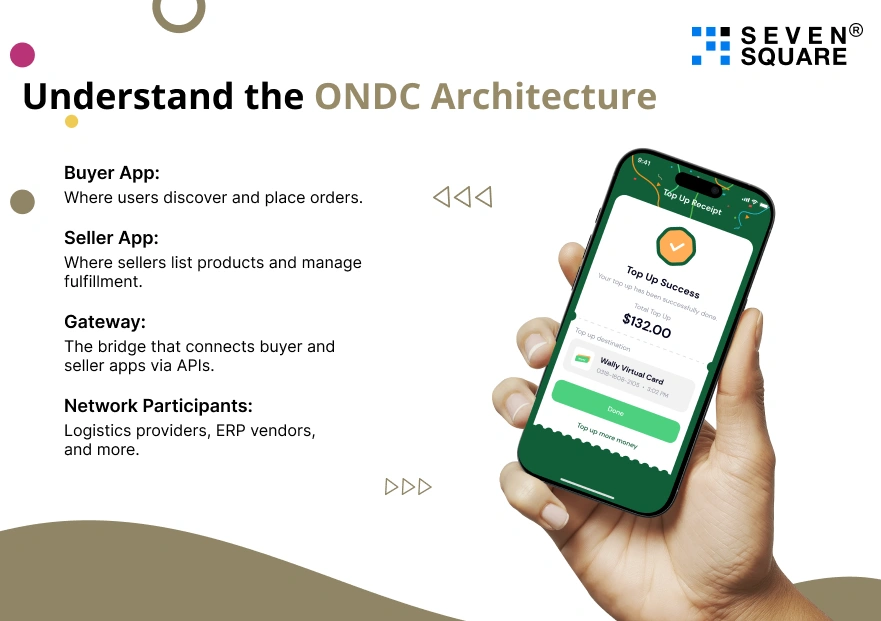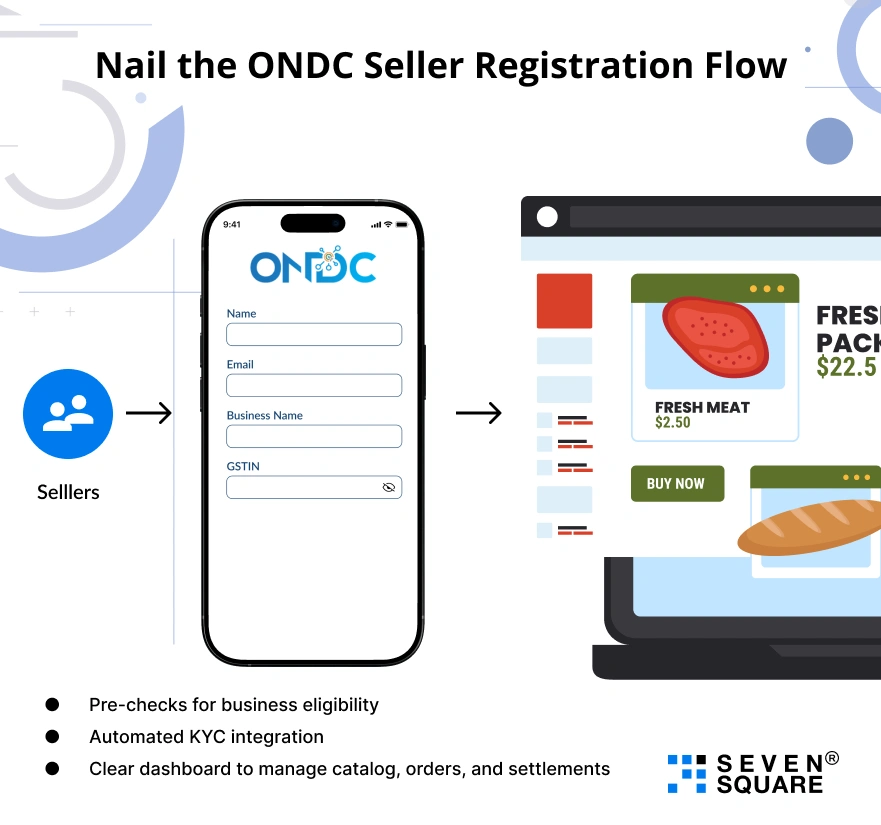You’ve probably been here: Your team is in the war room, whiteboards are full, and everyone’s asking the same question.
How do we tap into India’s booming digital commerce space without getting locked into the big marketplaces?
We’ve heard this from startup founders, mid-sized D2C brands, and even large enterprise teams.
The big players dominate with deep pockets, but there’s a shift coming as ONDC (Open Network for Digital Commerce) is flipping the game.
Building an ONDC marketplace isn’t a plug-and-play job.
It’s complex, regulated, and still evolving.
So, how do you move fast, stay compliant, and launch something that works?
That’s exactly what this blog answers.
Whether you’re planning to create an ONDC marketplace from scratch or exploring ONDC alternatives, this is perfect place for you.
Here you will get all the details about ONDC integration and how ONDC marketplace is changing the commerce industry.
Why ONDC Matters (and Why Now)?
ONDC is India’s bold move to democratize e-commerce by removing gatekeepers and putting control back in the hands of sellers, buyers, and technology partners.
It’s not a marketplace like Amazon or Flipkart. It’s a network. And to win here, you need a different playbook.
We’ve helped clients across retail, logistics, F&B, and pharma build ONDC-ready platforms. Here’s what we’ve learned: speed, clarity, and working tech wins.
What Are the Real Challenges of Building an ONDC Marketplace?
It’s not just about hiring a dev team. Here’s what you’re up against:
- Navigating the ONDC architecture and specifications
- Complying with strict technical and data standards
- Understanding the buyer and seller side integration
- Managing ONDC API integration and certifications
- Ensuring real-time performance, reliability, and scale
And that’s before you even think about design, product-market fit, or user adoption.
So, how do you build or create an ONDC marketplace like a pro?
Step-by-Step Guide to ONDC Marketplace Development
Step 1: Understand the ONDC Architecture

The first step is understanding the ONDC platform components:
- Buyer App: Where users discover and place orders.
- Seller App: Where sellers list products and manage fulfillment.
- Gateway: The bridge that connects buyer and seller apps via APIs.
- Network Participants: Logistics providers, ERP vendors, and more.
Your platform needs to plug into this structure while meeting ONDC compliance standards.
We have integrated Razorpay Payment Gateway in an app & the same we can do for your ONDC platform.
We’ve built buyer and seller apps from scratch and can tell you: this isn’t your average marketplace build.
It’s a decentralized mesh of services, and each one needs to speak the ONDC language.
Step 2: Define Your Role: Buyer App, Seller App, or Both?
One of the first strategic decisions is defining your marketplace’s role.
Are you creating a buyer app (serving customers), a seller app (serving merchants), or a full-stack platform?
Pro Tip: For startups, starting with a seller-first approach may give faster traction. That’s how one of our logistics-tech clients onboarded over 300 vendors in 60 days.
Step 3: Build for ONDC API Integration Early
ONDC APIs are non-negotiable. They’re the heartbeat of the network.
Every action, like search, cart, order, return, & rating, flows through ONDC APIs.
When building your ONDC marketplace, you’ll need to:
- Integrate open APIs per ONDC standards
- Handle encryption and digital signatures
- Enable audit logs and traceability
Avoid rework by using an API-first approach from day one.
We don’t just follow specs, but we help you translate them into user flows that make sense.
Step 4: Nail the ONDC Seller Registration Flow

One of the most overlooked (but critical) areas is the ONDC seller registration process.
Sellers want a smooth, low-friction onboarding. The moment you make it too complex or unclear, you lose them.
We recommend:
- Pre-checks for business eligibility
- Automated KYC integration
- Clear dashboard to manage catalog, orders, and settlements
This is where the magic happens. A flawless ONDC seller app is the engine of your marketplace.
Step 5: Ensure End-to-End ONDC Compliance
ONDC compliance isn’t just ticking a checklist. It’s a constant state:
- Data standards
- Response times
- Grievance redressal
- Pricing transparency
We help clients prepare for certification by running mock tests, validating data flows, and stress testing endpoints.
ONDC Marketplace Setup: A Closer Look
Launching a full marketplace like ONDC? Here’s what you need beyond APIs:
- Multi-role access control (for admin, sellers, buyers, support)
- CMS for banners, deals, and content
- Payment gateway integration (UPI, wallets, netbanking)
- Secure transactions with compliance-grade encryption
- Real-time order tracking
- Dispute resolution tools
If you’re building an ONDC marketplace for small businesses, make sure it’s lightweight, mobile-first, and works well even in low-bandwidth environments.
We’ve built systems like this for urban micro-delivery apps.
From Concept to Checkout: Your ONDC MVP
For most founders, the smartest path is launching a lean MVP:
- Pick a niche (e.g. grocery, fashion, pharma)
- Partner with 10–20 sellers
- Build a compliant ONDC seller app
- Connect to the ONDC gateway
- Go live, gather data, and iterate
Example: We helped a food delivery startup launch in 6 weeks by focusing only on the buyer-side MVP. They scaled to 1,000+ orders/day in under three months.
If you’re asking, “How to build an ONDC marketplace in India without burning a year and your budget?” this is it.
What Are the Best Practices and Learnings to Create ONDC Platform?
What Are the Best Practices and Learnings to Create ONDC Platform?
- APIs break so build for fallbacks.
- Use observability tools from day one. Logs, alerts, dashboards.
- Test with real users early. Don’t wait till it’s perfect.
- Document your ONDC onboarding process to save support tickets later.
- Make it mobile-first. Most users won’t touch your desktop site.
- Think product, not just tech. Good UX wins trust.
These aren’t theoretical points. We’ve made these mistakes so you don’t have to.
The ONDC Opportunity: Not Just for Big Brands

ONDC isn’t just for unicorns or government partners. It’s a massive opportunity for:
- Startups building vertical-specific commerce apps
- Agencies offering onboarding tools for sellers
- Logistics firms connecting to last-mile delivery
- Tech platforms powering fintech, healthtech, and B2B marketplaces
Want to explore a niche? We’ve helped teams from pharma to hyperlocal groceries figure out what works.
Whether you’re planning to create an ONDC marketplace, comparing ONDC alternatives, or scaling a robust platform, one thing matters: speed, clarity, and execution.
And that’s where Seven Square comes in.
Why Teams Trust Seven Square for ONDC Marketplace Development?
We’ve helped build buyer and seller apps, integrate ONDC APIs, pass certifications, and launch ONDC-compliant platforms fast.
We’ve delivered custom solutions across industries like retail, logistics, healthcare, food, education, and every time, we move with:
- Swift delivery (some MVPs launched in under 30 days)
- Clear communication (no jargon, just answers)
- Uncompromising quality (we ship code we’re proud of)
We’re not trying to sell you a dream. We’re here to help you build a real, working product.
Want to Build an ONDC-like marketplace? Contact Us Now!
Don’t Overthink, Start Smart
If you’re wondering, “Can I actually build or create an ONDC marketplace that works?” then yes, you can.
But you need the right partner, the right priorities, and a roadmap that starts small and moves fast.
Start with a focused MVP, test real flows, and build out from there.
ONDC is the future of digital commerce in India and you’re still early.
FAQs
- ONDC (Open Network for Digital Commerce) is an Indian government-backed initiative that aims to democratize digital commerce by creating an open, interoperable network.
- Unlike traditional marketplaces, ONDC allows buyers and sellers to connect directly through open protocols and APIs, no single platform controls the ecosystem.
- To create an ONDC marketplace, you’ll need to decide whether you want to build a Buyer App, Seller App, or both.
- Then, develop your platform in compliance with ONDC’s specifications, integrate the required APIs, and complete certification to go live on the network.
- Partnering with an experienced development team can speed up this process significantly.
- ONDC API integration requires you to:
- Use standard ONDC-compliant APIs (for search, order, fulfillment, etc.)
- Handle encryption and digital signing of transactions
- Implement audit logs and real-time monitoring
- Pass a certification process to ensure technical compliance
- Yes, alternatives include building a private marketplace, integrating with platforms like Udaan or JioMart, or using multi-vendor platforms like Shopify or WooCommerce.